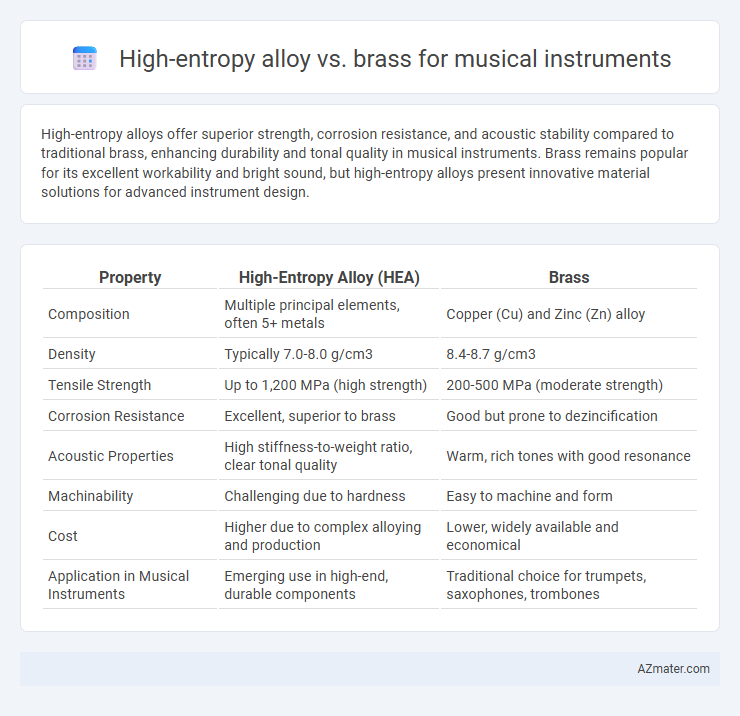High-entropy alloys offer superior strength, corrosion resistance, and acoustic stability compared to traditional brass, enhancing durability and tonal quality in musical instruments. Brass remains popular for its excellent workability and bright sound, but high-entropy alloys present innovative material solutions for advanced instrument design.
Table of Comparison
| Property | High-Entropy Alloy (HEA) | Brass |
|---|---|---|
| Composition | Multiple principal elements, often 5+ metals | Copper (Cu) and Zinc (Zn) alloy |
| Density | Typically 7.0-8.0 g/cm3 | 8.4-8.7 g/cm3 |
| Tensile Strength | Up to 1,200 MPa (high strength) | 200-500 MPa (moderate strength) |
| Corrosion Resistance | Excellent, superior to brass | Good but prone to dezincification |
| Acoustic Properties | High stiffness-to-weight ratio, clear tonal quality | Warm, rich tones with good resonance |
| Machinability | Challenging due to hardness | Easy to machine and form |
| Cost | Higher due to complex alloying and production | Lower, widely available and economical |
| Application in Musical Instruments | Emerging use in high-end, durable components | Traditional choice for trumpets, saxophones, trombones |
Introduction to High-Entropy Alloys and Brass
High-entropy alloys (HEAs) are advanced metallic materials composed of five or more principal elements in near-equal proportions, offering exceptional mechanical strength, corrosion resistance, and thermal stability. Brass, an alloy primarily of copper and zinc, has traditionally been used in musical instruments due to its excellent acoustic properties, workability, and corrosion resistance. Comparing HEAs with brass highlights the potential for HEAs to provide enhanced durability and novel sound qualities in musical instrument manufacturing.
Historical Use of Brass in Musical Instruments
Brass has been historically favored in musical instruments due to its excellent acoustic properties, durability, and ease of fabrication, making it the primary material for brass instruments like trumpets, trombones, and tubas since the 19th century. High-entropy alloys, a relatively recent development, offer enhanced mechanical strength and corrosion resistance but lack the proven acoustic characteristics and historical pedigree of brass in music. While high-entropy alloys show potential for future applications, brass remains the standard for musical instruments due to its established tonal quality and craftsmanship tradition.
Emergence of High-Entropy Alloys in Instrument Manufacturing
High-entropy alloys (HEAs) have emerged as innovative materials in musical instrument manufacturing due to their superior mechanical strength, corrosion resistance, and acoustic properties compared to traditional brass. These alloys consist of multiple principal elements, which create unique microstructures enhancing durability and sound quality, making them promising for applications in brass instruments like trumpets and trombones. Recent studies highlight HEAs' potential to improve tonal clarity and instrument longevity, offering a cutting-edge alternative to conventional brass compositions.
Acoustic Properties: High-Entropy Alloy vs Brass
High-entropy alloys exhibit superior acoustic damping properties compared to brass, resulting in clearer, more resonant tones that enhance sound quality in musical instruments. The complex microstructure of high-entropy alloys minimizes internal friction, allowing for sustained vibration and improved harmonic richness, whereas brass tends to produce brighter but less sustained tones. These acoustic advantages make high-entropy alloys a promising alternative for high-performance musical instrument components demanding precise tonal control.
Durability and Corrosion Resistance Comparison
High-entropy alloys exhibit superior durability and corrosion resistance compared to brass, making them more resilient to wear and environmental factors in musical instruments. Their complex multi-element composition results in enhanced mechanical strength and oxidation resistance, extending the lifespan of components exposed to frequent handling and moisture. Brass, while traditionally favored for its acoustic properties, is more susceptible to tarnishing and deformation over time under similar conditions.
Workability and Machining Differences
High-entropy alloys exhibit superior workability compared to brass due to their unique multi-element composition, allowing for enhanced ductility and resistance to deformation under mechanical stress. Machining high-entropy alloys requires specialized tools and controlled parameters because of their increased hardness and wear resistance, whereas brass machines easily with standard equipment, offering smoother cuts and less tool wear. The higher thermal conductivity of brass also facilitates efficient heat dissipation during machining, reducing the risk of thermal damage compared to high-entropy alloys.
Cost and Availability for Instrument Makers
High-entropy alloys (HEAs) present a higher material cost compared to traditional brass due to complex manufacturing processes and limited large-scale production, impacting budget-conscious instrument makers. Brass remains widely available and cost-effective, benefiting from well-established supply chains and extensive use in musical instrument fabrication. The choice between HEA and brass depends on balancing innovative material properties against practical considerations of cost and accessibility for craftsmen.
Sound Quality and Timbre Considerations
High-entropy alloys exhibit superior sound clarity and sustain in musical instruments due to their complex microstructure, which enhances vibration transmission compared to brass. Brass, with its well-balanced harmonic spectrum, provides a warm timbre favored in traditional instruments but often lacks the brightness and projection achievable with high-entropy alloys. The advanced acoustic properties of high-entropy alloys offer innovative possibilities for instruments requiring both dynamic range and tonal precision.
Environmental Impact and Sustainability
High-entropy alloys (HEAs) offer superior corrosion resistance and durability compared to traditional brass, reducing the frequency of replacements and waste generation in musical instruments. Brass production involves significant copper and zinc mining, which contributes to habitat disruption and heavy metal pollution, while HEAs often utilize a more diverse mix of elements that can be sourced with lower environmental footprint. Sustainable instrument manufacturing increasingly favors HEAs for their potential to minimize resource depletion and enhance long-term environmental performance.
Future Trends in Material Selection for Musical Instruments
High-entropy alloys (HEAs) offer promising advancements over traditional brass in musical instrument manufacturing due to their superior strength, corrosion resistance, and tunable acoustic properties. Future trends indicate a shift towards HEAs for enhanced durability and sound quality, driven by ongoing research in alloy composition and additive manufacturing techniques. Innovations in HEA design could lead to customizable tonal characteristics, outperforming brass in both professional and mass-produced instruments.

Infographic: High-entropy alloy vs Brass for Musical Instrument
 azmater.com
azmater.com